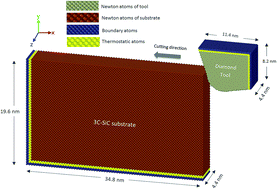Atomic-scale characterization of occurring phenomena during hot nanometric cutting of single crystal 3C–SiC
Abstract
Nanometric cutting of single crystal 3C–SiC on the three principal crystal orientations at various cutting temperatures spanning from 300 K to 3000 K was investigated by the use of molecular dynamics (MD) simulation. The dominance of the (111) cleavage was observed for all the tested temperatures. An observation of particular interest was the shift to the (110) cleavage at cutting temperatures higher than 2000 K. Another key finding was the increase of anisotropy in specific cutting energy from ∼30% at 300 K to ∼44% at 1400 K, followed by a drop to ∼36% and ∼24% at 1700 K and 2000 K, respectively. The obtained results also indicated that the specific cutting energies required for cutting surfaces of different orientations decrease by 33–43% at 2000 K compared to what are required at 300 K. Moreover, the position of the stagnation region was observed to vary with changes in temperature and crystallographic orientation. Further analysis revealed that the subsurface deformation was maximum on the (111) surface whereas it was minimum on the (110) plane. This is attributable to the occurrence of cleavage and the location of the stagnation region. In addition, the amount of subsurface damage scaled linearly with the increase of cutting temperature. A vortex flow of atoms beneath the cutting tool was also observed, which is qualitatively analogous to the plastic flow of silicon. The simulations also predicted that the atom-by-atom attrition wear and plastic deformation of the diamond cutting tool could be alleviated while cutting at high temperatures. Nevertheless, chemical wear i.e. dissolution–diffusion and adhesion wear is plausible to be accelerated at high temperatures.


 Please wait while we load your content...
Please wait while we load your content...